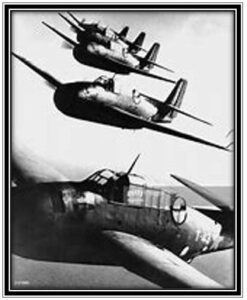By: Barry Fetzer, ECAHF Historian
Hello, fellow ECAHF’ers. Have you ever been lost? Those of us older than 50 probably can relate to that sinking feeling (no pun intended regarding the below article) when you begin to realize you have no idea where you are. Perhaps in the era of cell phones and GPS, that feeling happens less than it did back in the day when you could find no gas station to stop and ask for directions, your paper map wasn’t helping, nor were the directions the farmer gave you a few miles back. And you were getting low on gas.
It’s even worse for aviators than is for terrestrial transporters (or wheeled vehicle drivers), although it is an aviation mantra that aviators don’t actually ever get lost. No. They just get “temporarily disoriented”. But even for aviators who are merely “temporarily disoriented”, it can be quite disconcerting to realize you are unsure of your location and the fuel gauge is not on your side. Especially over water. Especially at night.
Temporary disorientation happened to me during my military flying career. More than once. One of the times, I was flying a helicopter and searching for an aircraft carrier, low on fuel, at night, in poor weather, the carrier’s navigational aids temporarily inoperative, and me “temporarily disoriented”. I remember the sense of losing my ability to think clearly…to consider alternatives…to plan ahead…to think beyond the immediate issue with which I was dealing. Well, all’s well that ends well and I ended up not having to ditch my aircraft, locating the carrier, and safely landing.
Another time I was flying a fixed wing aircraft from Florida to Cuba and there was a point midway when we lost navigational aid reception from the mainland (and communication with Center) and had not yet picked up communications from Guantanamo Bay. Same sinking feeling. But we made it to Gitmo.
So, I—like most aviators who have been temporarily disoriented—can relate to the feelings the pilots from Flight 19 and those on the search and rescue aircraft might have been feeling, temporarily disoriented, and their mental sharpness adversely impacted. None of them returned home and none of them have ever been found. Cue eerie music.
According to History.com: “At 2:10 p.m. on December 5, 1945, five U.S. Navy Avenger torpedo-bombers comprising Flight 19 took off from the Ft. Lauderdale Naval Air Station in Florida on a routine three-hour training mission. After having completed their objective, Flight 19 was scheduled to take them due east for an additional 67 miles, then turn north for 73 miles, and back to the air station after that, totaling a distance of 120 miles.

“They never returned.
“Two hours after the flight began, the leader of the squadron, who had been flying in the area for more than six months, reported that his compass and backup compass had failed and that his position was unknown. The other planes experienced similar instrument malfunctions. Radio facilities on land were contacted to find the location of the lost squadron, but none were successful. After two more hours of confused messages from the fliers, a distorted radio transmission from the squadron leader was heard at 6:20 p.m., apparently calling for his men to prepare to ditch their aircraft simultaneously because of lack of fuel.
“By this time, several land radar stations finally determined that Flight 19 was somewhere north of the Bahamas and east of the Florida coast, and at 7:27 p.m. a search and rescue Mariner aircraft took off with a 13-man crew. Three minutes later, the Mariner aircraft radioed to its home base that its mission was underway. The Mariner was never heard from again. Later, there was a report from a tanker cruising off the coast of Florida of a visible explosion seen at 7:50 p.m.
“The disappearance of the 14 men of Flight 19 and the 13 men of the Mariner led to one of the largest air and seas searches to that date, and hundreds of ships and aircraft combed thousands of square miles of the Atlantic Ocean, the Gulf of Mexico, and remote locations within the interior of Florida. No trace of the bodies or aircraft was ever found.
“Although naval officials maintained that the remains of the six aircraft and 27 men were not found because stormy weather destroyed the evidence, the story of the “Lost Squadron” helped cement the legend of the Bermuda Triangle, an area of the Atlantic Ocean where ships and aircraft are said to disappear without a trace. The Bermuda Triangle is said to stretch from the southern U.S. coast across to Bermuda and down to the Atlantic coast of Cuba and Santo Domingo.” BY: HISTORY.COM EDITORS
Onward and upward!
